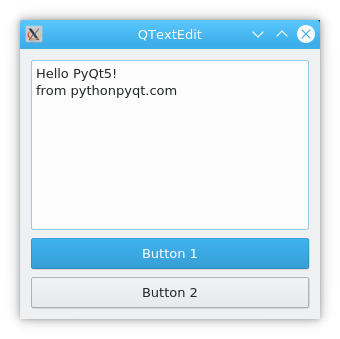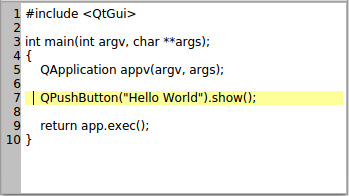
The icons are in the images directory which is directly under the TextEditor project directory. The text editor uses several icons to represent various actions.

The default project does not have any header files, therefore this is not visible.
 Headers - contains the C++ header files (. Resources - contains a resource file that configures the application assets and how the application resolves the location of the assets. Sources - contains the C++ implementation files (. Also sets the paths that are visible to the project. TextEdit.pro - the project file used to create the build files. The following project files are modified later in the guide: The wizard creates the project files used to build the project. Make sure that you can run the basic application and if not, make sure that your build environment and Qt version are configured. The application is an empty shell but it contains the basic window and layout on which we can build. The wizard creates the project and you can run it by clicking on the run button. In the Kit Selection page, select Next. In the Qt Quick component set field, select Qt Quick Controls 1.2 > Next. In the Name field, enter TextEditor and select Next. Select File > New File or Project > Applications > Qt Quick Application > Choose. Qt Creator has a wizard that can create the project for you. Our application has the name Text Editor and it is a Qt Quick Application. We can start by creating the project in Qt Creator. All files used in the application are listed for viewing in the Qt Quick Controls 1 - Text Editor Example page.
Headers - contains the C++ header files (. Resources - contains a resource file that configures the application assets and how the application resolves the location of the assets. Sources - contains the C++ implementation files (. Also sets the paths that are visible to the project. TextEdit.pro - the project file used to create the build files. The following project files are modified later in the guide: The wizard creates the project files used to build the project. Make sure that you can run the basic application and if not, make sure that your build environment and Qt version are configured. The application is an empty shell but it contains the basic window and layout on which we can build. The wizard creates the project and you can run it by clicking on the run button. In the Kit Selection page, select Next. In the Qt Quick component set field, select Qt Quick Controls 1.2 > Next. In the Name field, enter TextEditor and select Next. Select File > New File or Project > Applications > Qt Quick Application > Choose. Qt Creator has a wizard that can create the project for you. Our application has the name Text Editor and it is a Qt Quick Application. We can start by creating the project in Qt Creator. All files used in the application are listed for viewing in the Qt Quick Controls 1 - Text Editor Example page. 
The files are part of the Qt package and are available when searched for Qt Quick Text Editor in Qt Creator's Welcome mode.
#QT TEXT EDIT FREE#
Feel free to click on the links, but it is not necessary to leave the guide to find the information necessary to develop the application. The guide attempts to be self-contained but will refer to topics in the Qt reference documentation. If not, here are the pages that will help you: This guide assumes that you have downloaded Qt and are able to install, open, and run the basic examples found in Qt Creator's Welcome Mode. We will also implement the logic and connect the user interface to a C++ backend that will handle the saving and loading of text files. We will use Qt Quick Designer to add QML controls onto our application and set up the controls and resources. Specifically, the example uses QML to set up the user interface, C++ to implement the file operations, and the Qt tools to manage the project files and build environment. The Text Editor example is a simple example of creating an application with Qt.







 0 kommentar(er)
0 kommentar(er)
